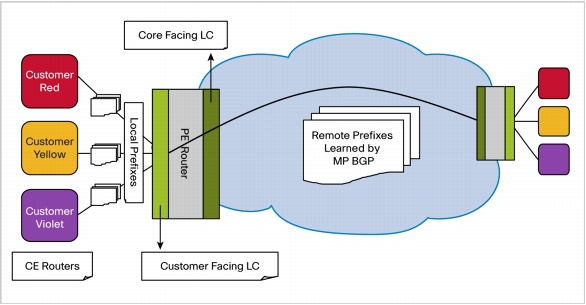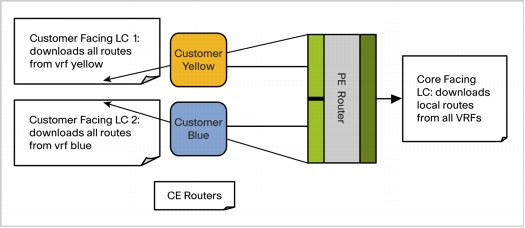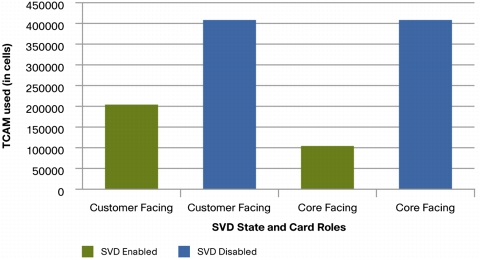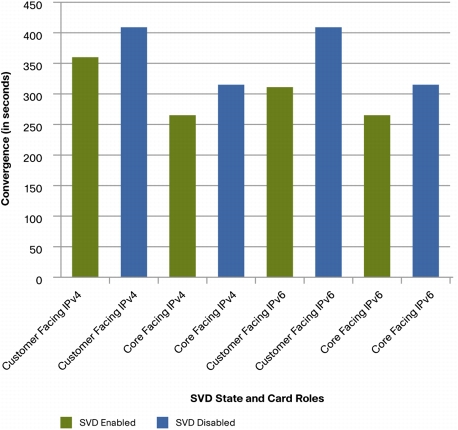What You Will Learn
• Provides an overview of Selective VRF download solution
• Introduces the filtering benefits of the solution
• Calculates savings and gains
• Presents some recommended deployment best practices
Background
Solution Overview
Figure 1. Selective VRF Download Basic Technology

• Core facing role: A card that has only core-facing interfaces (interfaces that connect to other provider core and provider edge devices). These are the interfaces which would be provisioned under default VRF.
• Customer facing role: A card that has only customer-facing interfaces (interfaces that connect to customer edge devices in named VRFs).
• Local route: A route that is received from a customer edge device connected to the router in a configured VRF context.
• Remote route: A route received from another provider edge device multiprotocol BGP (MP BGP) and is imported to a configured VRF.
• Locally significant table: When a VRF is provisioned to an IP numbered interface that has its data plane on the card, it will be considered as a locally significant table (LST) for the card. VRF tables that are LST for a card are downloaded to the card.
• Inter-table dependency: From the definition, VRF is an independent routing table instance. Under most instances a VRF will not be dependent on another instance, but there are two main exceptions where routes could have next-hops in another VRF:
– Inter-VRF static routing
– BGP extranets
If a VRF table is dependent on another table, then that table also becomes LST (though indirect) and needs to be downloaded to the card. This process continues until all recursions are resolved, and it is performed on each card in a truly distributed manner.
VRF and Route Filtering
• Core facing cards download routes for all VRFs, but only the local routes. Route filtering is done on the forwarding cards based on card role and route type.
• Customer facing cards download all routes only for VRFs that are significant to the line card. Table filtering is done on the route processor card based on the LST download requests from the forwarding cards.
Figure 2. Selective VRF Download Filtering

Savings Calculation
• n is the total number of VRFs present
• o is the number of VRF directly provisioned/configured on the card, (n![]() o)
o)
• R is routes per VRF
• x is the ratio of SVD local: total routes
• Y is the number of VRFs dependant on directly provisioned VRFs (o), (Y![]() 0)
0)
Table 1. Total Tables and Routes Downloaded by Line Card Type
• Without SVD: (nR) = 100,000
• On customer-facing card: (o+Y)R = 25,000
• On core-facing card: (nxR) = 30,000
Recommended Deployment
• Separate customer cards from core. Planning a specific role for each card, rather than keeping both global and customer interfaces on the same card, brings the maximum benefits and savings. We recommend not mixing cards for different SVD roles.
• Try to minimize the dependency between VRFs. Interdependence among tables causes more and more tables to be downloaded to each card. This recursion could be difficult to realize and break. Hence we recommend avoiding multilevel recursive dependency among VRFs.
• Keep your interface configuration clean. Stray configurations can cause more VRFs to be considered locally significant and be downloaded. Those VRFs could further have dependencies and those dependencies would also be downloaded.
SVD on Cisco IOS XR Software
Extensions
• Per address family filtering: The SVD solution is IP address family independent. This means that a card role can be calculated or assigned for each address family. VRF and route filtering also occurs per address family.
• Not-interested role: If a card is not participating in forwarding for a particular address family, the card is classified as having a not-interested role and no tables or routes for the address family are downloaded.
• Pure L3VPN role: For pure L3VPN customer cards, where global routing information is not needed, default table BGP routes are filtered and only IGP routes in the default table along with VRF routes are programmed. This helps in further scaling the forwarding cards.
• Automatic card role calculation: The SVD feature uses interface-VRF mappings and interface-IP configuration to automatically predict the user intent for deployment of a card and need for a particular VRF on a particular card. Only if a VRF is provisioned to an IP-assigned interface will it be considered an LST. In certain deployment scenarios such as 6VPE, where routes from one address family recurse over routes from another address family, the card roles are adjusted automatically to the optimal roles.
• Automatic SVD route type promotion: The SVD feature automatically promotes the SVD route type of remote routes as local if there exists a recursion of another local route over it. This ensures that due to filtering of remote routes on Core facing cards, local routes recursing over remote routes are not left unresolved.
Specifics
• The default VRF is present on all cards. Cards with Not-Interested role for an address family create it but do not contain any routes in it for that address family.
• For an IPv4 address family, the card role never automatically arrives as not interested. This is done primarily because of the lack of pure IPv6 deployments.
Savings Metrics
Table 2. System Profile used for savings measurement
Figure 3. Ternary Content Addressable Memory (TCAM) Savings

Figure 4. Convergence Gains

Conclusion
• The SVD feature optimizes the VRF and route download to multicard routing systems, thereby saving precious hardware memory and network processing unit resources. Existing low-memory forwarding cards can be deployed as core facing, thereby protecting your investment.
• SVD improves scalability, reduces convergence time, and does not affect existing features such as BGP Prefix-Independent Convergence (PIC). If VRF is considered LST for a card, only then it will be downloaded to the card. This helps ensure that only what is actively required is downloaded. VRF and route filtering are based on SVD card role.
For More Information
• RFC 4364, BGP/MPLS IP VPNs, Rosen and Rekhter, February 2006
• RFC 2858, Multiprotocol Extensions for BGP4, Bates, Chandra, Katz, and Rekhter, June 2000
• RFC 5291, Outbound Route Filtering Capability for BGP-4, Chen, and Rekhter, August 2008
• RFC 4684, Constrained Route Distribution for Border Gateway Protocol/MultiProtocol Label Switching(BGP/MPLS) Internet Protocol (IP) Virtual Private Networks(VPNs), Marques, P. et. al, November 2006